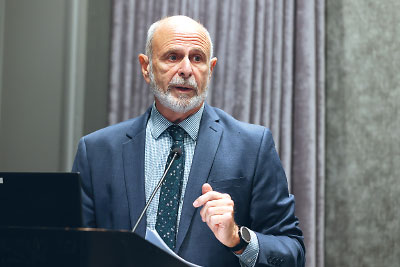Several touchpoints in the criminal justice process offer opportunities to identify the mental health and substance use treatment needs of people who enter the system, said experts at APA’s Mental Health Services Conference. Much of the discussion focused on the Sequential Intercept Model, which was developed in the early 2000s by Policy Research Associates and has since garnered widespread use as a planning tool for reducing justice system involvement of people with mental and substance use disorders.
The Sequential Intercept Model recognizes that decisions regarding the individual are made at multiple points as the person moves through the system: at arrest, at initial detention and the first court appearance, at jails and courts, at release on probation or parole, and at reentry into the system if probation or parole is revoked.
“Since we know that we have people with mental health and co-occurring conditions in the criminal justice system, if we could just identify them at each of these intercept points and then route them out to get them into a treatment door, we might be able to ultimately reduce the penetration of this population [in jails and prisons],” said Debra Pinals, M.D., senior medical and forensic advisor and editor-in-chief at the National Association of State Mental Health Program Directors and director of the Program in Psychiatry, Law, and Ethics at the University of Michigan Medical School.
Pinals emphasized the importance of intervening as early as possible in a person’s journey into the criminal justice system.
“Data show that the more we can get people out of pretrial detention, the better, because it’s not good for people [to be there]. They can end up potentially being more at risk for criminal recidivism,” Pinals said.
David Morrisette, Ph.D., L.C.S.W., spoke about jail diversion programs. He is a senior consultant at NRI, a national organization based in Falls Church, Va., that provides support in the areas of public behavioral health analysis, evaluation, and research.
“The point of diversion is not just to engage somebody in a mental health court or crisis system. It’s really to engage them in treatment so they stay in treatment,” Morrissette said. He added that after speaking to project directors throughout the nation, he found that they identified four elements that are necessary for a jail diversion program to succeed: peer support; efforts to improve health equity; early engagement of stakeholders such as police and mental health professionals; and organizational empathy, such as mental health professionals learning about how the correctional system is structured and about the challenges correctional officers face at work.
Erin Comartin, Ph.D., L.M.S.W., an associate professor at the Wayne State University School of Social Work, discussed the importance of discharge planning for people who are exiting the criminal justice system and reentering their communities. She encouraged jail-based discharge planning wherein a health or mental health professional provides services such as setting appointments and making referrals, offers resource sheets, or holds individual or group meetings. Comartin differentiated between prisons, which include longer lengths of stay but are more amenable to planned reentry to the community, and jails, which have shorter lengths of stay that make reentry planning more difficult.
Yet whether a person is reentering the community from a prison or jail, “the goal of reentry is to return the individual to the community with no further offenses and with successful illness management and recovery,” Comartin said.
She described a study in Michigan wherein the researchers found that only 37% of individuals who had serious mental illness and were reentering their communities from a jail had received discharge planning services. Of those who did not receive discharge planning services, 62% were in jail for more than four days, signifying a missed opportunity.
Comartin said there was a significant link between discharge planning and the likelihood of a person receiving care upon leaving the jail: 53% of those who received discharge planning engaged in post-release mental health treatment, compared with 39% who did not receive discharge planning.
Comartin added that when people move back into their communities, the services available to them should be targeted to their needs.
“The idea is that you focus on the highest risk population and tailor treatment services in ways that are amenable to them,” Comartin said. “You want to make sure that the treatments [are designed] so the individual can actually do and participate in them.”
“Also take stock of what the attitudes are in the community. Some communities have much higher levels of stigma around behavioral health needs … so knowing what is going on in that community and what the temperature is for different types of reentry services is critical,” Comartin said.
Former Ohio State Supreme Court Justice Evelyn Stratton, J.D., offered pointers for pulling together and implementing programs for people with mental or substance use disorders who are in the criminal justice system, using the Ohio Project’s Stepping Up Initiative as an example. The Stepping Up Initiative (a program of which the APA Foundation is a partner) helps people with mental illness who have been in the criminal justice system connect to treatment and other services.
Stratton stressed the importance of perseverance and working with stakeholders who are open to communicating and working together.
“One thing I learned is that if you get somebody who will answer their phone calls, you can get a meeting together,” Stratton said. She added that events like conferences are excellent for networking, learning what others are doing in terms of working with people with mental and substance use disorders in the criminal justice system, and finding like-minded individuals. ■



